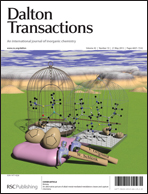Dithia[3.3]paracyclophane-based monometal ruthenium acetylide complexes: synthesis, characterization and substituent effects†
Abstract
A series of dithia[3.3]metaparacyclophane-based monometal ruthenium acetylide complexes have been synthesized. All of the complexes have been fully characterised by ![[triple bond, length as m-dash]](https://www.rsc.org/images/entities/char_e002.gif) C) bands of these complexes in the neutral state and little effect on ν(C
C) bands of these complexes in the neutral state and little effect on ν(C![[triple bond, length as m-dash]](https://www.rsc.org/images/entities/char_e002.gif) C) of these complexes in the oxidized state.
C) of these complexes in the oxidized state.
![Graphical abstract: Dithia[3.3]paracyclophane-based monometal ruthenium acetylide complexes: synthesis, characterization and substituent effects](/en/Image/Get?imageInfo.ImageType=GA&imageInfo.ImageIdentifier.ManuscriptID=C3DT50234A&imageInfo.ImageIdentifier.Year=2013)

 Please wait while we load your content...
Please wait while we load your content...